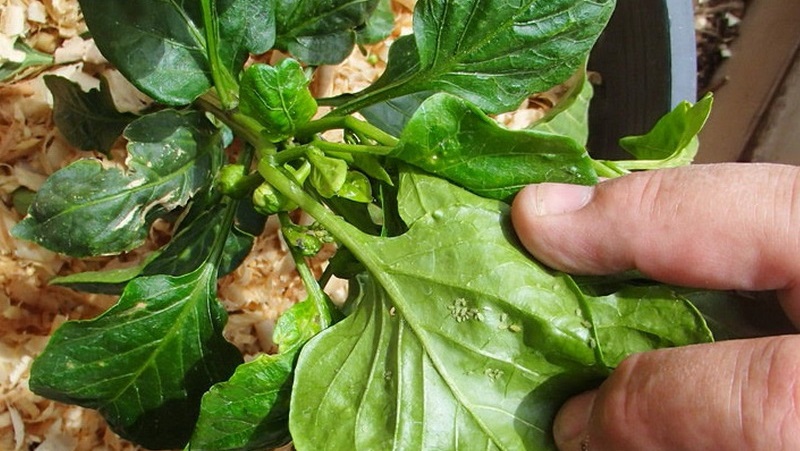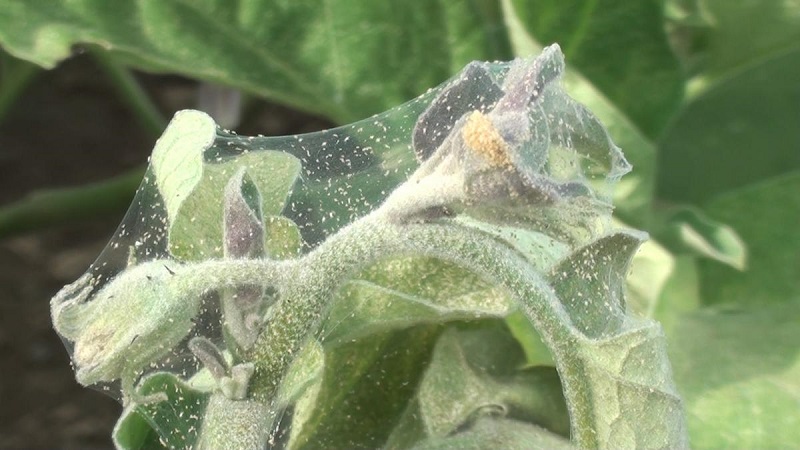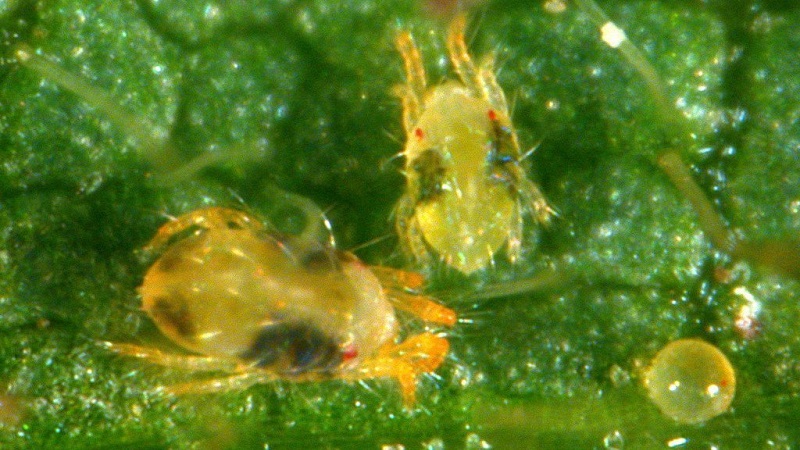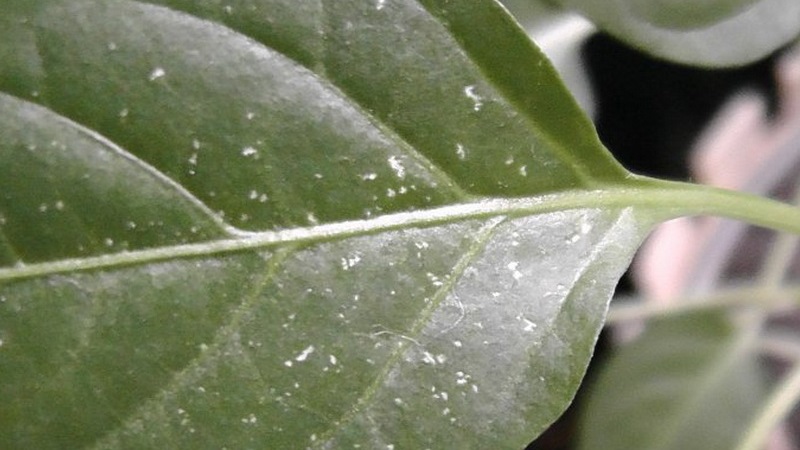How to deal with spider mites on pepper seedlings: effective methods for quickly defeating the pest
Growing sweet bell pepper - troublesome occupation. It is necessary not only to create favorable conditions for growth, but also to protect the plant from pests, one of which is a spider mite.
One female spider mite is capable of producing 8-20 generations per season, or about two thousand individuals. A serious threat, isn't it? What a pest looks like, how to deal with it, how to treat plants at various degrees of infection - we will tell you in detail in the article.
The content of the article
What does a spider mite look like
A common pest on pepper is the common spider mite (Tetranychus urticae). Belongs to the family "spider mites" (lat. Tetranychidae), a subclass of mites, arachnids class.
Females reach sizes from 0.4 to 0.6 mm, males from 0.3 to 0.45 mm. On the front part of the body are two pairs of simple eyes.
Sexually mature parasites are dark green, greenish-gray or yellow. The body is convex at the top, flat at the bottom.
Fertilized females before hibernation turn orange-red, stop feeding and go underground or fallen leaves, and, having gathered in dense groups, hibernate.
Spherical eggs, transparent with a greenish tint, in the later stages of development, they look like pearls. The larvae are almost transparent, light green or greenish brown, with dark spots on the sides.
Common spider mites live in colonies in which there are individuals at all stages of development: eggs, larvae, adult pests.

Signs of appearance
Spider mites pierce the skin of pepper leaves and suck out the cell sap. Their saliva contains an enzyme that breaks down the chloroplasts of cells.
Plants attacked by spider mites look like this:
- the edges of the leaf blades are curled, the petioles are deformed;
- dehydrated leaf veins form a marble pattern;
- brown spots appear on the underside of the leaves, after a while the leaf dries up and falls off;
- buds wither;
- growth slows down;
- a cobweb is visible on the lower part of the leaf (colonies first of all settle there);
- with further reproduction of the pest, the plants are completely covered with cobwebs; a mass of moving ticks is visible on the tips of the shoots with the naked eye.
Infection routes
Pepper infection can occur in several ways:
- the tick is carried by the wind on its web;
- the parasite can get into the garden on clothes, shoes or on animal hair;
- crawls from infected plants to closely spaced healthy plants.

Spider mite on pepper seedlings
On pepper seedlings, spider mites are almost invisible at an early stage of infection. In order to take preventive measures in time and notice the problem, you need to know the reasons for the appearance of the parasite and the favorable conditions for its existence.
Reasons for the appearance
Spider mite colonies develop when:
- high ambient temperature - mites are activated at a temperature of 16-20⁰С, reproduction is accelerated when the temperature is above 25⁰С;
- low humidity - comfortable humidity for the parasite is 40-50%;
- insufficient watering of pepper - with a lack of water in plant tissues, the content of soluble carbohydrates increases, which contribute to the reproduction of mites;
- excess nitrogen fertilization - plants with excessive green mass are more attractive to pests.
Harm done
Spider mites, feeding on pepper juices, interfere with normal metabolic processes and weaken the plant. The spider webs surrounding the leaves interfere with photosynthesis. Damage to the epidermis contributes to infection with fungal and viral diseases.
The activity of the pest leads to a significant decrease in the yield, and in advanced cases - to the death of plants.

Control methods
What to do to remove spider mites? Methodically and regularly process the beds, especially since the arsenal of means and methods for destroying the parasite is wide.
Biological preparations
The most common biologicals contain populations of phytoseilus (predatory mites) that feed only on spider mites. The agent is poured into special applicators that are hung on the plant stems. The temperature 25-27⁰С and the humidity 60-70% are favorable for useful predators, therefore this method is more often used in greenhouses.
The drug is used immediately after purchase, since phytoseiluses do not live long. You can buy it in shops for summer cottages and gardens.
Chemicals
To obtain the effect and your own safety, chemical preparations must be used in strict accordance with the instructions.
Important! Ticks are classified as arachnids, so only acaricidal or insectoacaricidal chemicals are suitable for killing them.
Among vegetable growers, several drugs have earned a reputation:
- "Akarin" - acaricide of intestinal action, active ingredient - avertin-N. 8-16 hours after treatment, the ticks stop feeding and move. "Akarin" does not affect pest eggs. The drug is extremely toxic to bees.
- Apollo - narrowly targeted acaricidal agent of contact action, the active ingredient is clofentezin. It has a detrimental effect on the eggs and larvae of the spider mite. Adults do not die, but they lose the ability to reproduce. The action of the drug lasts from 30 to 60 days. Safe for beneficial insects and predatory mites.
- "Actellik" - insectoacaricide of intestinal action, the active ingredient is pyrimophos-methyl (phosphoranic compound). The protective effect lasts up to ten days. Dangerous for bees.
- Fitoverm - insectoacaricide of intestinal action, the active ingredient is aversectin C, leads to paralysis, and then to the death of parasites. Protects plants for up to two weeks. The drug is dangerous for bees.
Spider mites quickly develop resistance to chemicals, so the same product cannot be used multiple times. Failure to comply with the recommended dosages also leads to parasite resistance.

Traditional methods
Folk remedies should be used at the initial stages of infection or during fruiting. They are not as potent as chemicals, but they can reduce parasites.
Experienced summer residents advise using the following recipes:
- Dissolve a bar of laundry soap in a bucket of water. With the resulting solution, wash the leaves of the plants with a sponge.
- Insist 400 g of dry tobacco or makhorka in 10 liters of water for a day, then boil and strain. Dissolve 50 g of laundry soap in the cooled broth. Dilute the resulting liquid with water 1: 1 and spray vegetables.
- Chop 500 g of garlic and add three liters of water. Insist 5 days in the dark. To process peppers, 60 ml of the resulting extract is diluted in a bucket of water and 50 g of grated soap is added.
Agrotechnical techniques
Agrotechnical measures to combat spider mites include:
- deep autumn digging of beds - contributes to the death of parasites from low temperatures in winter;
- tillage of the soil in greenhouses in spring with sulfur sticks - to destroy still dormant pests;
- the distance between the beds should be at least 80-90 cm - this will limit the spread of the parasite to healthy plants;
- crop rotation - replacement of crops in the garden: for example, in the place of peppers for the next year, you can plant tomatoesthat ticks do not live on;
- careful weeding - so that in early spring the females of ticks have nowhere to develop;
- reasonable feeding with nitrogen fertilizers - an excess of nitrogen leads to an accelerated reproduction of pests;
- planting varieties resistant to spider mite.

Pepper seedlings processing rules
It is recommended to process seedlings at a temperature of at least 18 ° C, otherwise the effectiveness of most products decreases. It is better to carry out work on a clear, windless day in the late morning, when the dew has dried.
Spraying with chemicals and folk remedies should be carried out in closed clothes, a headdress, a respirator, glasses, gloves. The presence of children and animals at this time on the site is unacceptable.
The nuances of fighting in the greenhouse and in the open field
Measures to combat spider mites in the greenhouse and in the open field are similar.
However, the limited space of greenhouses promotes more rapid spread of pests. Delay in the fight against mites in the greenhouse threatens with loss of yield.
Using chemicals indoors should be done with caution. After processing, it is not recommended to enter the room for 24 hours.
Preventive measures
To save time and money, it is better to take the following preventive measures on time:
- In autumn, remove all fallen leaves and plant residues from the garden.
- Dig up the soil and treat with an acaricidal agent.
- Remove all weeds in time.
- Water regularly.
- Conduct preventive spraying with acaricidal chemicals or folk remedies.
- Maintain a humidity of 60-70% and a temperature of up to 25⁰C in the greenhouse (these are the conditions that are unfavorable for the reproduction of spider mites).
- At the end of the season, wash and disinfect the greenhouse, remove plant residues, treat the soil with sulfur bombs.
- Plant peppers next to garlic and onions, as tetranychid ticks avoid them.
Tips & Tricks
Several recommendations of experienced gardeners.
- If small parts of the plants are affected, they must be immediately removed along with the parasites. There will not be much harm to the pepper, but the spread of the mite will be significantly reduced.
- At the initial stage of infection, parasites can be manually removed or washed off with soapy water.
- To increase resistance to parasites, it is necessary to increase the immunity of pepper. For this, stimulants are used, for example, "Immunocytofit", "Karvitol".
- Foliar phosphorus-potassium dressings increase resistance to tick infestation.
Conclusion
Spider mites are a real disaster for peppers. A small tick, invisible to the naked eye, is difficult to immediately notice. A slowdown in growth, the appearance of brown spots and cobwebs on the leaves already signal a serious damage to the plant. But do not give up. In the arsenal of vegetable growers there are enough means of struggle: biological chemicals, folk recipes and, most importantly, correct agricultural technology.